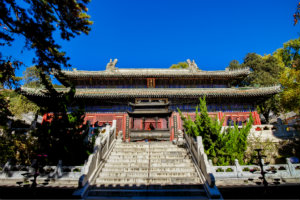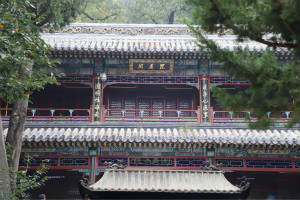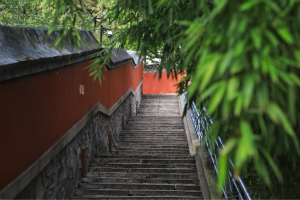Chinese Name: 潭柘寺 Pronunciation: Tánzhè Sì
Building Time: 307
Admission Ticket Fare: 55 yuan
Recommended Time for Visit: 2-3 hours
Address: Tanzhesi Town, Mentougou District, Beijing
Occupied Area: About 121 hectares (1,210,000 square meters)
Ticket Free of Charge Policy: Children under 1.2 meters are free of charge.
| Attraction | Peak Season (April 1st to October 31st) |
Low Season (November 1st to March 31st) |
| Tanzhe Temple | 8:00 - 17:00 | 8:00 - 16:30 |
The Tanzhe Temple is located at the foot of Tanzhe Mountain in the southeastern part of Mentougou District in the west of Beijing, more than 30 kilometers from the city center. The temple faces south, with its back to Mount Baozhu, surrounded by nine high mountains. The high mountains block the cold currents coming from the northwest, so the climate here is warm and humid.

The temple boasts ancient trees, numerous pagodas, and magnificent halls. The whole temple buildings are arranged in perfect order according to the terrain. What is more, the scenery is extremely beautiful with fresh bamboos and varieties of flowers.
The Tanzhe Temple covers an area of 2.5 hectares (25,000 square meters) inside the temple and 11.2 hectares (112,000 square meters) outside the temple. Besides, the surrounding forests and mountain fields governed by the Tanzhe Temple cover a total area of more than 100 hectares. The palaces are built with the height of the hills and are scattered in a row.
The Forbidden City in Beijing has 9,999 and a half rooms, while the Tanzhe Temple had 999 and a half rooms in its heyday in the Qing Dynasty, just as a miniature of the Forbidden City. The story goes that when the Forbidden City was built in the early Ming Dynasty, it was modeled after the Tanzhe Temple.

At present, the Tanzhe Temple has a total of 943 houses, including 638 ancient halls, which maintain the style and appearance of the Ming and Qing Dynasties. It is the largest ancient temple building complex in the suburbs of Beijing. The whole building group fully embodies the aesthetic principles of Chinese ancient architecture, with a central axis running through the center. The left and right sides are basically symmetrical, which makes the whole building complex appear regular, strict, prioritized, and clearly graded. Its architectural forms are diverse, including the palace, hall, pavilion, tower, altar, etc.
The Tanzhe Temple is not only rich in the cultural landscape but also enchanting in the natural landscape. It enjoys beautiful scenery in all seasons and has different features in the morning, afternoon, and evening. As early as the Qing Dynasty, “Ten Scenes of Tanzhe” has been famous in Beijing.
The Tanzhe Temple not only attracts guests and tourists from all over the world with its numerous historical sites and beautiful scenery but also has built modern tourism service facilities in recent years. It aims to provide a one-stop service of transportation, accommodation, catering, sightseeing, entertainment, and shopping, making the scenic spot a famous tourist attraction at home and abroad. In 1997, with the approval of the Beijing Municipal Government, the monks resumed their religious activities at the Tanzhe Temple.
The Tanzhe Temple was built in the first year (307AD) of Yongjia’s reign in the Western Jin Dynasty and was the earliest temple built after Buddhism entered the Beijing area. At that time, it was not large and was called the Jiafu Temple. Buddhism, as a foreign religion, had neither been accepted by the people nor supported by the local government in the early days of its introduction into Beijing. As a result, it developed very slowly.

Later, the temple was destroyed twice by the Northern Wei Dynasty and the Northern Zhou Dynasty, which made Buddhism suffer a great blow. Since its establishment, the Jiafu Temple had little influence and had no development. It was not until the Tang Dynasty that it flourished.
During the reign of Empress Wu Zetian in the Tang Dynasty (696-697), the Buddhist monk Huayan came to Tanzhe Mountain to build a temple. He purchased land from the Jiang family on the western slope and the Liu family on the eastern slope, and rebuilt the temple around the ruined Jiafu Temple.
Monk Huayan led the monks to fill in a large puddle called “Blue Dragon Pool” in the temple, built the temple hall, expanded the temple grounds, and created the original Tanzhe Temple. Then, the Tanzhe Temple had a certain scale and became well-known in the Youzhou region. It gradually developed and flourished, so that the later generations revered monk Huayan as the "founding father" of the Tanzhe Temple.

During the Huichang period of the Tang Dynasty, Li Yan (Emperor Wuzong of the Tang Dynasty), who believed in Taoism, was encouraged by Taoist priest Zhao Guizhen and a powerful official Li Deyu to destroy Buddhism throughout the country. As a result, the Tanzhe Temple was again abandoned.
During the late Tang Dynasty, when the famous Zen monk Congshi came to the Tanzhe Temple to eradicate the desolation and renovate the temple, the Tanzhe Temple flourished once again. The temple was then changed from the Huayan School to the Zen School.
In the Ming Dynasty, from the time of Emperor Zhu Yuanzhang onward, most of the emperors and concubines believed in Buddhism. Besides, the eunuchs were so favored and powerful that they used up their savings to build temples everywhere to have a place to stay after they aged out of the palace. The Tanzhe Temple was renovated and expanded several times, either by imperial grants or donations from eunuchs, so that it became what it is today.
The Qing Dynasty was the most glorious period in the history of the Tanzhe Temple. During the Qing dynasty, the Tanzhe Temple changed from the Zen school to the Vinaya school, and there were many masters of Vinaya. During the Qing Dynasty, four emperors, namely Kangxi, Yongzheng, Qianlong, and Jiaqing, visited the Tanzhe Temple many times to offer incense and rituals to the Buddha, which played a great role in raising the status of the Tanzhe Temple. With the favor of the emperors, the Tanzhe Temple was able to take advantage of this situation to purchase additional land, expand its forest and mountain farms, and develop into a huge temple landowner estate. At this time, the Tanzhe Temple had reached the peak of its history.

In the courtyard of the West Avalokitesvara Cave, there is a cave on the west side of the cliff, where a seated statue of Avalokitesvara is worshipped, blessing all who come for incense. Outside the cave, there are two wells close to each other, called “God Tiger Spring”, whose water is cool, pure, and a little bit sweet. The stone pavers in the southeast corner of the yard of the cave lead to a small courtyard, which is the Tiger Cave, formerly called Bodhi Cave. Inside the cave is a statue of Monster Yin Liang who was called the Lunatic Monk, with a crouching tiger next to him on the right.

Today, there are more than seventy tomb stupas of various forms from different dynasties in the Forest of Stupas in the front of the temple. The stupa with the most buried monks is the "Shi-Fang Pu-tong Ta". This stupa was built in the 42nd year (1614) of the Wanli period of the Ming Dynasty. Over the centuries, the number of monks buried in the stupa was difficult to count, thus people also called the stupa “the Stupa of Ten Thousand Monks”.

The Emperor Tree is the most famous of the ancient trees in the Tanzhe Temple, reaching a height of over 40 meters and a diameter of over 4 meters. The tree was planted in the Liao Dynasty (907-1125) and is now a thousand years old. It is said that in the Qing Dynasty, a new branch grew from the root of the tree once there was a new emperor who succeeded to the throne. When the Qianlong Emperor visited the temple, he named the tree the “Emperor Tree”, which was the highest title ever given to a tree by an emperor.
Enter from the gateway of the Tanzhe Temple—The Emperor Tree—Magnolia Denudata Called Two Beauties of Qiao—The Sala Tree—The West Avalokitesvara Cave—The Forest of Stupas—Vairochana Pavilion—The Jietai Temple
Take bus 931 and get off at the Tanzhe Temple Station.
Chinese: 请带我去潭柘寺。English: Please take me to the Tanzhe Temple.
If you go to the Tanzhe Temple from the center of Beijing (Grand Hyatt Beijing), it takes about 1 hour (about 140 yuan).
If you go to the Tanzhe Temple from Beijing Capital International Airport, it takes about 2 hours (about 250 yuan).
If you go to the Tanzhe Temple from Beijing Daxing International Airport, it takes about 1.3 hours (about 300 yuan).
If you go to the Tanzhe Temple from Beijing West Railway Station, it takes about 42 minutes (about 100 yuan).
